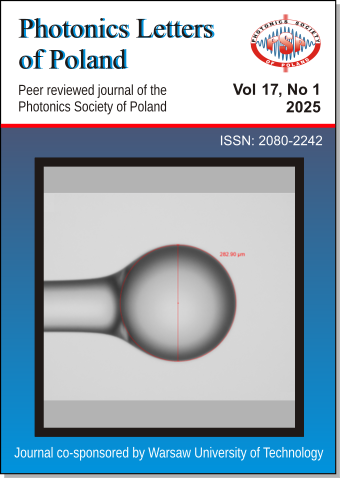Investigation of using neural networks for temperature and relative humidity measurement with the Rayleigh scattering-based distributed optical fiber sensor
DOI:
https://doi.org/10.4302/plp.v17i1.1315Abstract
The paper presents an investigation of neural networks for temperature and relative humidity (RH) measurement by Rayleigh-based distributed optical fiber sensor (DOFS). The sensor consists of bare and polyimide-coated fibers placed side by side, ensuring different sensitivities to temperature and RH. Two neural networks have been thoroughly examined in sensor data processing: Multilayer Perceptron (MLP) and Convolutional Neural Networks (CNN). These models were assessed in terms of mean square errors (MSE) and training time. The MLP model achieves better results with lower training time compared to CNN. The proposed solution enables fast and automatic sensor data analysis after model training.
Full Text: PDF
References
- Z. Ding et al., "Advances in Distributed Optical Fiber Sensors Based on Optical Frequency-Domain Reflectometry: A Review", IEEE Sensors Journal 23, 26925 (2023). CrossRef
- L. Palmieri, L. Schenato, M. Santagiustina, A. Galtarossa, "Rayleigh-Based Distributed Optical Fiber Sensing", Sensors 22, 6811 (2022). CrossRef
- P. Bulot, R. Bernard, M. Cieslikiewicz-Bouet, G. Laffont, M. Douay, "Performance Study of a Zirconia-Doped Fiber for Distributed Temperature Sensing by OFDR at 800 °C", Sensors 21, 3788 (2021). CrossRef
- J. Li et al., "High spatial resolution distributed fiber strain sensor based on phase-OFDR", Opt. Expr. 25, 27913 (2017). CrossRef
- P.J. Thomas, J.O. Hellevang, "A fully distributed fibre optic sensor for relative humidity measurements", Sensors and Actuators B: Chemical 247, 284 (2017). CrossRef
- M. F. Bado, J. R. Casas, "A Review of Recent Distributed Optical Fiber Sensors Applications for Civil Engineering Structural Health Monitoring", Sensors 21, 1818 (2021). CrossRef
- Z. Han et al., "Simultaneous humidity and temperature measurement sensor based on two cascaded long-period fiber gratings", Opt. Comm. 530, 129137 (2023). CrossRef
- Z. Ding et al., "Indoor Optical Wireless Channel Characteristics With Distinct Source Radiation Patterns", IEEE Photon. J. 8, 1 (2016). CrossRef
- B.K. Choi et al., "Simultaneous Temperature and Strain Measurement in Fiber Bragg Grating via Wavelength-Swept Laser and Machine Learning", IEEE Sensors J. 24, 27516 (2024). CrossRef
- S. Sarkar, D. Inupakutika, M. Banerjee, M. Tarhani, M. Shadaram, "Machine Learning Methods for Discriminating Strain and Temperature Effects on FBG-Based Sensors", IEEE Photon. Technol. Lett. 33, 876 (2021). CrossRef
- C. Zhu, O. Alsalman, "Vernier effect-based optical fiber sensor for dynamic sensing using a coarsely resolved spectrometer", Opt. Expr. 31, 22250 (2023). CrossRef
- Y. Mei, T. Xia, H. Cai, Z. Liu, "Deep Learning Improved Spectral Demodulation of Interferometry Vernier Effect for Pressure Sensing", J. Lightw. Technol. 42, 430 (2024). CrossRef
- C. Karapanagiotis, K. Hicke, A. Wosniok, K. Krebber, "Distributed humidity fiber-optic sensor based on BOFDA using a simple machine learning approach", Opt. Expr. 30, 12484 (2022). CrossRef
- C. Karapanagiotis, K. Hicke, K. Krebber, "Machine learning assisted BOFDA for simultaneous temperature and strain sensing in a standard optical fiber", Opt. Expr. 31, 5027 (2023). CrossRef
- M. Mądry, B. Szczupak, M. Śmigielski, B. Matysiak, "Simultaneous Temperature and Relative Humidity Measurement Using Machine Learning in Rayleigh-Based Optical Frequency Domain Reflectometry", Sensors 24, 7913 (2024). CrossRef
- B. Szczupak et al., "The Influence of Germanium Concentration in the Fiber Core on Temperature Sensitivity in Rayleigh Scattering-Based OFDR", IEEE Sensors Journal 21, 20036 (2021). CrossRef
- F. Rosenblatt, "The perceptron: A probabilistic model for information storage and organization in the brain.", Psycholog. Rev. 65, 386 (1958). CrossRef
- Y. LeCun, L. Bottou, Y. Bengio, P. Haffner, "Gradient-based learning applied to document recognition", Proc. IEEE 86, 2278 (1998). CrossRef
Downloads
Published
How to Cite
Issue
Section
License
Copyright (c) 2025 Mateusz Mądry, Bogusław Szczupak, Mateusz Śmigielski, Bartosz Matysiak

This work is licensed under a Creative Commons Attribution 4.0 International License.
Authors retain copyright and grant the journal right of first publication with the work simultaneously licensed under a Creative Commons Attribution License that allows others to share the work with an acknowledgement of the work's authorship and initial publication in this journal. Authors are able to enter into separate, additional contractual arrangements for the non-exclusive distribution of the journal's published version of the work (e.g., post it to an institutional repository or publish it in a book), with an acknowledgement of its initial publication in this journal. Authors are permitted and encouraged to post their work online (e.g., in institutional repositories or on their website) prior to and during the submission process, as it can lead to productive exchanges, as well as earlier and greater citation of published work (See The Effect of Open Access).




